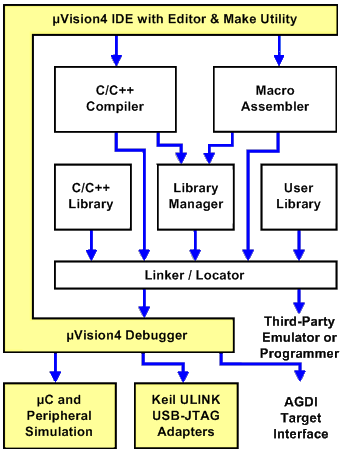|
||
| Products Download Events Support Videos | ||
Technical Support
On-Line Manuals
µVision User's Guide
Software Development Cycle
The software development cycle is roughly the same in µVision as it is in any other software development tool.
- Create a project, select the target chip from the device database, and configure the tool settings.
- Create source files in C/C++ or assembly.
- Build the application with the project manager.
- Correct errors in source files.
- Test the linked application.
The following block diagram illustrates the complete µVision software development cycle. Each component is described below.

µVision IDE
The µVision IDE integrates a project manager, a rich-featured editor with interactive error correction, make utility, configuration options, and online help dialogs. Use µVision to create source code files and organize them into a project that defines the target application. µVision compiles, assembles, and links automatically the embedded application and provides a single focal point for your development efforts.
C/C++ Compiler & Macro Assembler
Source files are created by the µVision IDE and are passed to the C or C++ Compiler or Macro Assembler. The compiler and assembler process source files and create relocatable object files.
Library Manager
The library manager allows creating object libraries out of the compiled and assembled object modules. Libraries are specially formatted ordered program collections of object modules that may be used by the linker at a later time. When the linker processes a library, only those modules are used that are necessary to create the program.
Linker/Locator
The Linker/Locator creates an executable program file using the object modules extracted from libraries and those created by the compiler and assembler. An executable program file (also called absolute object module) contains no relocatable code or data. All code and data reside at fixed memory locations.
This executable program file can be used:
- To program an Flash ROM or other memory devices.
- With the µVision Debugger for simulation and target debugging.
- With an in-circuit emulator for the program testing.
µVision Debugger
The µVision symbolic and source-level debugger is ideally suited for fast reliable program debugging. The debugger includes a high-speed Simulator for simulating an microcontroller system, including on-chip peripherals, and external hardware. The chip attributes are configured automatically when the device is selected from the Device Database.
The µVision Debugger provides several ways to test programs on hardware.
- Use a ULINK Debug and Trace Adapter to download the application to Flash and to testing the software.
- Use the Keil AGDI interface to connect the µVision Debugger front end to the target system. The interface allow you to use other debuggers like Monitor, In-System Debugger, or Emulator.
ProductsDevelopment Tools |
Hardware & Collateral |
Downloads |
Support |
Contact |
